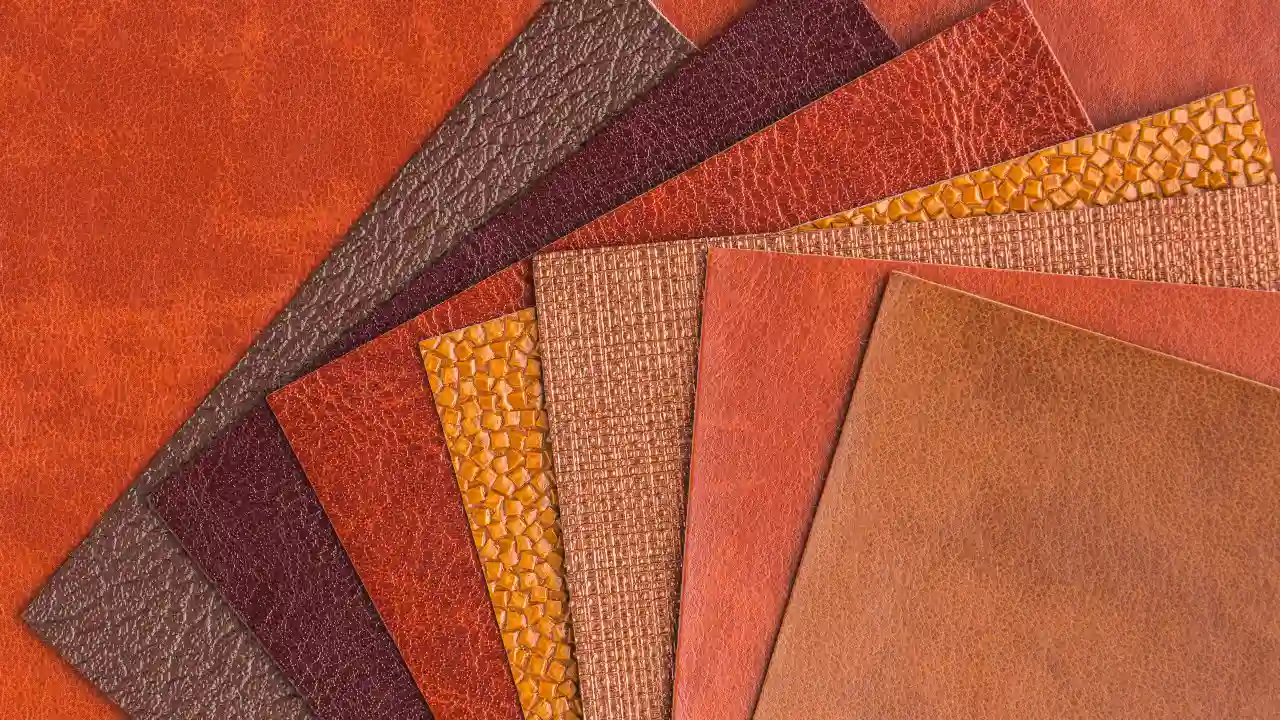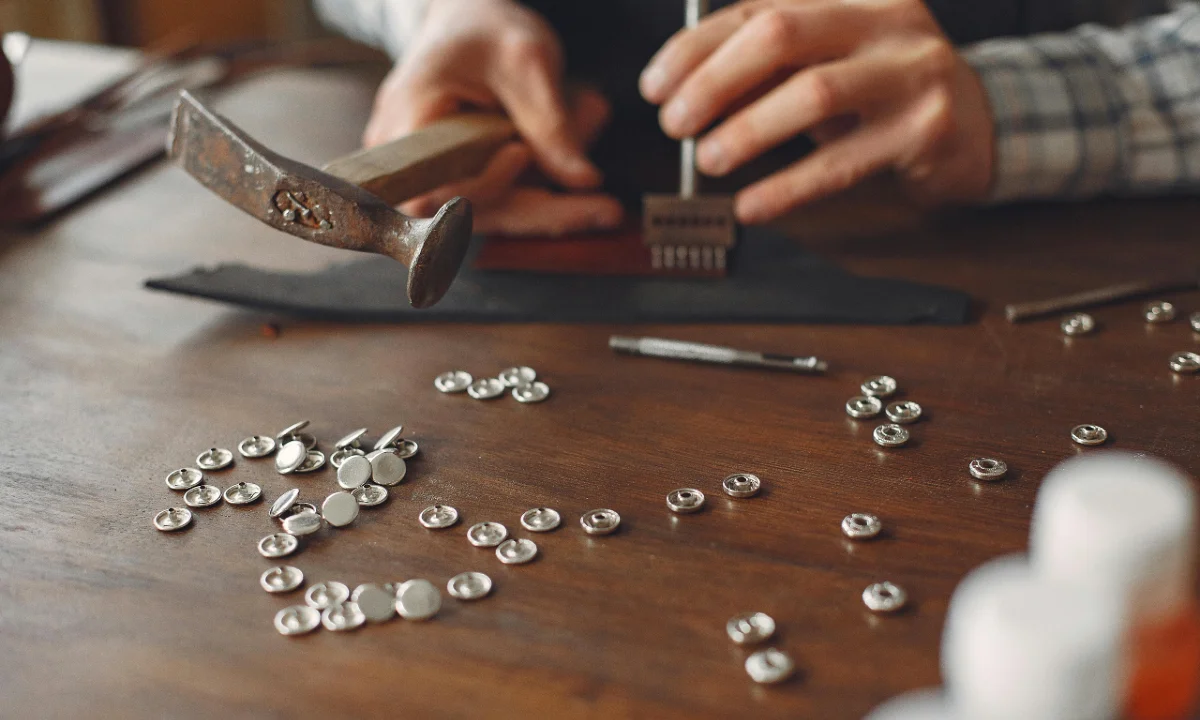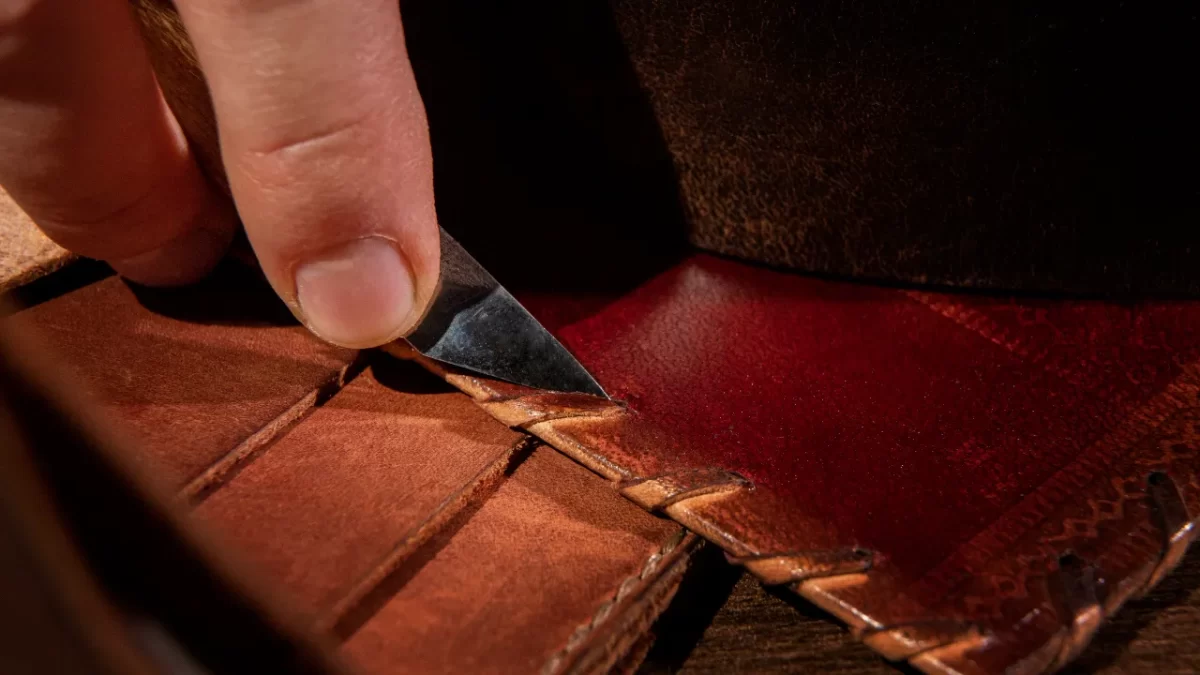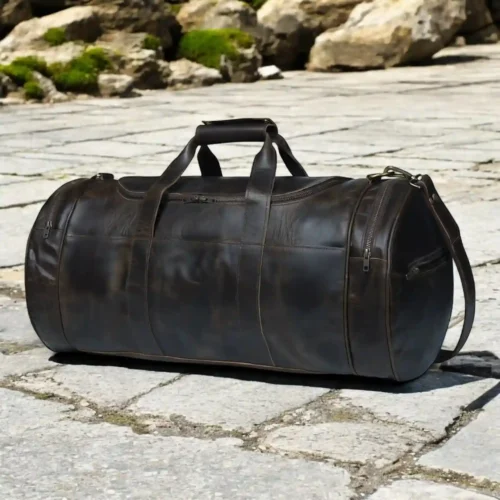🚛 FREE SHIPPING | LIFETIME REPAIR WARRANTY | 20% Sale: “FREEDOM20”

Leather embossing is a sophisticated technique used to create intricate designs and textures on leather surfaces. This process enhances the aesthetic appeal of leather products, making them unique and visually appealing. At Saintstag, we specialize in embossing leather to achieve stunning results that stand out in the market. This article will delve into the meaning of embossing in leather, the process involved, various techniques, and popular leather embossing patterns. Whether you’re a hobbyist looking to learn how to emboss leather or a professional seeking advanced methods, this guide has you covered.
Leather embossing is the art of creating decorative designs on leather by pressing patterns into its surface. This process can be done using various methods, such as dry embossing, heat embossing, and wet embossing. Each method involves different tools and techniques to achieve the desired effect. Embossing in leather not only enhances its visual appeal but also adds texture and dimension, making it suitable for a wide range of applications, including fashion accessories, home décor, and personalized gifts. At Saintstag, our expertise in embossing on leather ensures high-quality, durable designs that stand the test of time. Whether you are interested in learning how to emboss on leather at home or seeking professional services, understanding the intricacies of leather embossing is crucial.
Embossing leather is a crucial technique in leather craftsmanship, enhancing both the aesthetic and functional aspects of leather products. This process involves creating raised or recessed designs on leather surfaces, which adds depth, texture, and visual appeal. Embossing in leather is widely used in the fashion industry to create unique patterns and logos on leather bags, wallets, belts, and more. It also plays a significant role in differentiating products by adding a touch of sophistication and personalization. Understanding how to emboss leather and the various leather embossing patterns available can elevate the quality and exclusivity of your leather goods whether working with different leather types or distinguishing between real vs fake leather, mastering how to emboss on leather ensures high-quality and durable designs that meet consumer expectations.
Leather embossing has a rich history, with traditional techniques still widely used today. One such method is hand embossing, where artisans use metal stamps and mallets to imprint designs onto leather. This technique requires skill and precision, as each stamp must be carefully aligned and struck with consistent force. Another traditional approach is using heat and pressure through tools like embossing irons or heated plates. This method, known as hot stamping, helps create durable and intricate patterns. Both techniques are essential for embossing leather, adding unique textures and depth to products like womens leather duffle bags, leather sling bags for ladies, and leather sling bag men’s. These time-honored methods ensure high-quality, personalized designs that stand the test of time.

Hand tool embossing is a traditional method that involves using manual tools to create intricate designs on leather. This technique requires a high level of craftsmanship and precision, as artisans use various tools such as styluses, bevelers, and pear shaders to carve and press designs into the leather surface. This method of embossing leather is ideal for creating detailed and unique patterns on items like leather journals and vintage messenger bags, adding a personal touch and artisanal quality to each piece.
Stamping techniques are popular for embossing leather because they allow for consistent and repeatable designs. In this process, metal stamps with pre-designed patterns are pressed onto the leather using a mallet or press. This method is excellent for creating logos, monograms, and decorative elements on products such as leather messenger bags for women and brown leather briefcase. Stamping ensures precision and uniformity, making it a preferred choice for both custom and mass-produced leather goods.
Heat embossing, also known as hot stamping, involves using heated tools to press designs into the leather. This technique enhances the durability and clarity of the embossed patterns, making them resistant to wear and tear. Embossing on leather with heat creates a permanent impression that is both visually appealing and long-lasting. This method is particularly effective for items exposed to frequent use, such as wallets and belts, as well as larger pieces like leather journals. Understanding how to emboss on leather using heat is essential for achieving high-quality, professional results.
Advancements in technology have revolutionized leather embossing, introducing precision and efficiency to the craft. Modern techniques for embossing leather include digital design and laser cutting, hydraulic press embossing, 3D printing, and embossing rollers. These methods enhance the accuracy and complexity of designs, catering to both mass production and bespoke creations. Understanding how to emboss leather using these modern techniques ensures superior results and durability, making them ideal for various applications in fashion and accessories.
Digital design and laser cutting are at the forefront of modern leather embossing. This technique involves creating detailed designs using computer software and then using a laser to cut or engrave the pattern onto the leather. This method allows for high precision and intricate detail, making it perfect for embossing on leather items like handbags and wallets. Learning how to emboss on leather using digital and laser techniques can significantly elevate the quality and customization of leather goods.
Hydraulic press embossing utilizes powerful presses to imprint designs onto leather. This method is highly effective for large-scale production, ensuring consistent and high-quality results. Hydraulic presses can apply significant force, allowing for deep and detailed impressions, ideal for products such as belts and bags. Understanding how to emboss leather with a hydraulic press is essential for manufacturers looking to produce durable and intricate embossing in leather on a large scale.
3D printing is an innovative approach to embossing leather, allowing for the creation of complex and custom designs with high precision. This technique involves printing a 3D mold or stamp that can be used to emboss the leather. It is particularly useful for creating bespoke designs and prototypes. Using 3D printing for embossing on leather offers flexibility and creativity, enabling artisans to experiment with unique patterns and textures.
Embossing rollers are cylindrical tools used to imprint continuous patterns onto leather surfaces. This technique is efficient for creating repetitive designs and textures, making it ideal for applications like belts, straps, and upholstery. The rollers are often engraved with specific patterns that transfer onto the leather as it passes through. Mastering how to emboss on leather with embossing rollers can streamline production and ensure uniformity across large quantities of leather goods.

Selecting the appropriate leather embossing technique depends on your specific needs, the type of leather, and the desired design complexity. For those new to embossing leather, traditional hand tool embossing offers a hands-on approach that allows for creative experimentation. If you are looking for precision and efficiency, modern methods like digital design and laser cutting or hydraulic press embossing are ideal. Understanding how to emboss leather with each technique can help you achieve the best results. Whether you need intricate patterns or large-scale production, knowing how to emboss on leather effectively will ensure your projects stand out.
Leather embossing is a meticulous process that enhances the beauty and value of leather products by creating intricate designs and patterns. This guide will walk you through the essential steps on how to emboss leather, from selecting the right materials to gathering the necessary tools for a successful embossing project.
Selecting the appropriate leather type is crucial for achieving high-quality embossing in leather. Full-grain leather is ideal due to its durability and ability to hold detailed patterns. Top-grain leather is another excellent choice, offering a smooth surface that responds well to embossing. Avoid using bonded leather, as it lacks the structural integrity required for detailed embossing. By choosing the right leather, you ensure that the embossing on leather is both aesthetically pleasing and long-lasting.
To achieve professional results in leather embossing, having the right tools is essential. Basic tools include a set of metal stamps, a mallet, and an embossing plate. For more intricate designs, consider using a digital design tool and a laser cutter. Additionally, a heating element is necessary for techniques that require heat. These tools will help you master how to emboss on leather effectively, ensuring precise and detailed patterns. Investing in high-quality tools is crucial for both beginners and experienced artisans to produce exceptional embossing leather projects.
Proper preparation is key to successful leather embossing. Start by cleaning the leather to remove any dirt or oils that could interfere with the embossing process. Use a damp cloth and let the leather dry completely. Conditioning the leather can also make it more pliable, enhancing the quality of the embossing on leather. For best results, ensure the leather is evenly moistened, as this helps the embossing pattern to imprint more effectively. Understanding how to emboss leather begins with meticulous preparation, setting the foundation for a flawless design.
Accurate placement of the embossing pattern is crucial for achieving a professional look. Lay the leather on a flat, stable surface and position your embossing stamp or template. Secure the leather to prevent any movement during the embossing process. Carefully align the pattern to ensure it is straight and centered. This step is essential for precise embossing in leather, as any misalignment can affect the final outcome. Knowing how to emboss on leather with precision ensures that your designs are both beautiful and accurate.
Applying the right amount of pressure is vital to achieve a clear and lasting embossing effect. For manual embossing, use a mallet to strike the stamp firmly and evenly across the pattern. If using a press, ensure the pressure is distributed uniformly. The amount of pressure needed can vary depending on the leather thickness and the intricacy of the design. Proper technique in embossing leather ensures that the pattern is deeply and consistently imprinted, resulting in a high-quality finish. Mastering how to emboss leather with the right pressure is key to creating stunning leather products.
After applying the necessary pressure, it’s time to carefully remove the embossing pattern. Gently lift the stamp or template away from the leather to reveal the imprinted design. Be cautious during this step to avoid smudging or distorting the newly embossed pattern. The precision of this stage is crucial in embossing leather to ensure that the design remains sharp and clear. Mastering how to emboss leather includes understanding the importance of this delicate process to achieve professional and pristine results.
Once the pattern is embossed, it’s important to let the leather dry thoroughly. Place the leather in a cool, dry place away from direct sunlight to prevent any warping or discoloration. This drying process helps set the embossed design firmly into the leather. Allowing the leather to dry completely is essential for the longevity and durability of the embossing on leather. Understanding how to emboss on leather involves recognizing the significance of proper drying techniques to maintain the integrity of your design.
After the leather has dried, apply a leather conditioner or finish to protect and enhance the embossed design. This step not only adds a layer of protection but also gives the leather a polished and professional look. You may also choose to apply dye or paint to accentuate the embossed areas, adding depth and contrast to your design. The finishing touches in leather embossing are what bring your project to life, ensuring that the embossing in leather stands out beautifully. Learning how to emboss leather includes mastering these final steps to achieve a truly refined and high-quality product.

Leather embossing featuring floral motifs is a classic choice that adds a touch of elegance and sophistication to any leather item. These patterns often include intricate designs of flowers, leaves, and vines, creating a timeless and graceful appearance. Floral motifs are commonly used for embossing on leather accessories like wallets, purses, and belts. The delicate details in these patterns require skill and precision, making them a favorite among artisans who know how to emboss leather with finesse.
Geometric designs are a popular choice for embossing leather, offering a modern and stylish look. These patterns include shapes such as squares, triangles, and hexagons arranged in repetitive sequences or complex formations. Geometric designs are ideal for products like phone cases, notebooks, and bags, providing a contemporary aesthetic. Mastering how to emboss on leather with geometric patterns involves precise alignment and consistent pressure to achieve clean, sharp lines.
The basket weave pattern is a traditional embossing in leather technique that mimics the appearance of woven material. This design adds texture and depth to leather goods, making them visually interesting and unique. Basket weave is often used for items like belts, wallets, and straps, giving them a rustic and handcrafted feel. Learning how to emboss leather with a basket weave pattern requires attention to detail to ensure the woven effect is realistic and well-defined.
Tribal patterns are inspired by indigenous art and culture, featuring bold and striking designs. Embossing on leather with tribal motifs can add a cultural and artistic element to your products. These patterns often include intricate lines, symbols, and shapes that represent various cultural stories and traditions. Tribal embossing is perfect for items like cuffs, jackets, and bags, providing a unique and personalized touch. Understanding how to emboss leather with tribal designs involves capturing the essence of these intricate patterns.
Vintage patterns evoke a sense of nostalgia and timeless beauty. These designs often include intricate scrollwork, filigree, and classic motifs that harken back to earlier eras. Embossing in leather with vintage patterns can give products a distinguished and elegant look, perfect for items like journals, bags, and accessories. Knowing how to emboss on leather with vintage designs involves mastering the fine details that make these patterns stand out.
Personalized embossing allows for unique, custom designs tailored to individual preferences. This can include monograms, names, logos, or custom artwork, making each item one-of-a-kind. Leather embossing with personalized patterns is popular for gifts, promotional items, and personal accessories. Understanding how to emboss leather with personalized designs ensures that each piece is crafted to perfection, reflecting the personal touch of the artisan and the unique identity of the owner.
Uneven embossing is a common issue that can detract from the quality of your leather embossing project. This problem often occurs when inconsistent pressure is applied, leading to sections of the design being deeper or shallower than others. To troubleshoot this, ensure that you are applying even pressure across the entire stamp or tool. Using a hydraulic press can help maintain consistent force. Additionally, make sure the leather is evenly moistened, as dry spots can resist the embossing process, causing irregularities in embossing leather.
Sticking or dragging occurs when the embossing tool or stamp sticks to the leather surface, causing unwanted marks or distorted patterns. This issue can be minimized by ensuring that the leather is properly conditioned and lubricated before starting the embossing in leather process. Using a release agent on the stamp can also help. If the problem persists, check the stamp’s cleanliness and smoothness, as any residue or rough edges can cause dragging. Knowing how to emboss leather correctly includes preparing both the leather and tools adequately to prevent sticking.
Blurry impressions result from the embossing stamp moving slightly during the pressing process, causing a double or shadow effect. To avoid this, secure the leather firmly in place and ensure that the stamp is held steady. Using a press with a locking mechanism can provide better stability than hand-held tools. Additionally, check that the embossing plate is clean and free of debris, as dirt can cause slippage and blurry embossing on leather. Proper setup and a steady hand are crucial for achieving clear, crisp designs.
Misaligned patterns can ruin the symmetry and overall look of your design. This often happens if the leather or the embossing stamp shifts during the process. To troubleshoot this issue, use guides or markers to align your stamp correctly before applying pressure. Securing the leather on a non-slip surface and using clamps can help keep everything in place. Understanding how to emboss on leather with precision involves careful setup and alignment to ensure that your patterns are perfectly positioned.
Ink bleeding can occur when too much ink is applied, or the leather absorbs the ink unevenly. This problem is particularly common with detailed or fine patterns. To prevent ink bleeding, use a light hand when applying ink and allow each layer to dry thoroughly before adding more. Additionally, treating the leather with a sealant before embossing can create a barrier that prevents excessive absorption. Mastering how to emboss leather with ink requires practice and a careful approach to applying color, ensuring sharp and vibrant designs without unwanted bleeding.
Leather embossing is an intricate and rewarding craft that enhances the beauty and functionality of leather products. By mastering various techniques and understanding how to emboss leather effectively, artisans can create stunning, unique designs. At Saintstag, we emphasize the importance of precision and quality in embossing leather. Whether you are dealing with issues like uneven embossing or aiming to perfect your craft, knowing how to emboss on leather correctly is crucial. From selecting the right materials to applying the finishing touches, each step plays a vital role in achieving exceptional embossing on leather. Embrace the art of leather embossing and elevate your craftsmanship to new heights.
Embossing leather at home without a machine is achievable with a few simple tools. Start by selecting a high-quality piece of leather and a suitable leather embossing stamp or tool. Moisten the leather slightly to make it more pliable. Place the leather on a hard, flat surface and position your embossing tool. Use a mallet to gently tap the tool, pressing the design into the leather. Repeat as needed to achieve the desired depth. Understanding how to emboss leather by hand allows you to create unique, custom designs without the need for specialized equipment.
Heat can be used in leather embossing to create more defined and permanent impressions. Embossing on leather with heat involves using heated tools or stamps to press designs into the leather. The heat softens the leather fibers, allowing for deeper and clearer patterns. However, it is possible to emboss leather without heat by using pressure alone, especially with softer leathers. Knowing how to emboss on leather with and without heat provides flexibility in achieving different effects and textures in your projects.
Embossing in leather involves creating raised or recessed designs by pressing patterns into the surface. This technique adds texture and dimension without removing any material. In contrast, engraving leather involves cutting or carving into the leather to create designs, removing material in the process. Leather embossing patterns typically result in smoother, less permanent designs compared to engraving, which produces more detailed and lasting effects. Understanding the difference between embossing leather and engraving helps in choosing the right technique for your project.
The longevity of leather embossing depends on factors such as the quality of the leather, the embossing technique used, and the care given to the item. High-quality embossing leather using proper techniques can last for many years, especially if the leather is well-maintained. Regular conditioning and proper storage will help preserve the embossed design. Learning how to emboss leather correctly ensures that your embossed patterns remain crisp and durable, enhancing the beauty and value of your leather goods over time.


